Abstract
Background:
Rapid and right intervention of parents can limit disability and increase the chances of survival of the injured child and make a big difference in the outcome.
Objectives:
The objective of this study is to assess the knowledge and practice of first aid among parents attending PHCs in Al-Madinah city, 2017.
Methods:
A cross-sectional study was conducted in governmental primary healthcare centers in Al-Madinah Al-Munawwarah city (Saudi Arabia) during the year 2017. A representative sample of Saudi parents who live in Madinah and came to family medicine clinic in PHC was included. A pre-validated and self-administered questionnaire was used for data collection.
Results:
The study included 390 parents. More than half of them (55.6%) were males. The age of 40% of them ranged between 31 and 40 years whereas that of 31.5% ranged between 20 and 30 years. Majority of the parents (97.2%) were aware of first aid. The most commonly reported source of information about first aid was mass media (59%). Majority of the parents (93.3%) believe there must be training in first aid, and only 34.6% of them claimed that they attended a training course in first aid. The highest average knowledge percentage was observed regarding the first aid of diabetes mellitus (68.8%), followed by epilepsy (49.7%), incidents (37.5%) and finally injuries/fractures (36.7%). Higher educated parents, those with a moderate number of children (4–6), those reported nurses as the main source of information, those previously attended training in first aid, and those who had experience with incidents among their children expressed higher significantly first aid knowledge compared to their counterparts.
Conclusions:
First aid of various illnesses among parents in Al-Madinah city is not satisfactory, particularly regarding incidents, injuries, and fractures. However, the majority of them were willing to attend training courses in first aid at primary healthcare centers.
Keywords: First aid, parents, primary care
Introduction
Childhood injury is a major public health problem that requires urgent attention. Injury and violence is a major killer of children worldwide, responsible for about 950 000 deaths in children and young people under the age of 18 years each year.[1]
Unintentional injuries account for almost 90% of these cases. They are the leading cause of death for children aged 10–19 years. In addition to the deaths, tens of millions of children require hospital care for nonfatal injuries. Many are left with some form of disability, often with lifelong consequences.[1]
Children spend most of their time at home under the care of their parents, especially their mother. Children are interested in discovering new things, this make them at high risk of unintentional injuries and death. Rapid and right intervention from parents can limit disability and increase the chances of survival of the injured child and make a big difference in the outcome. A caregiver should have an appropriate and adequate amount of first-aid knowledge and practice.
First aid can define as helping behaviors and initial care provided for an acute illness or injury. The goals of a first-aid provider include preserving life, alleviating suffering, preventing further illness or injury, and promoting recovery.[2]
Objective
General objective
The objective of this study is to assess the knowledge and practice of first aid among parents attending Primary Health Care Centers (PHCs) in Al-Madinah city, 2017.
Specific objective
To find out the knowledge of parents regarding first aid
To identify the first aid practice among parents
To identify the willingness of parents to learn about first aid
To identify the sources of first-aid knowledge among parents.
Methods
Study setting and population
This cross-sectional study. was conducted in the governmental primary healthcare centers in Al-Madinah Al-Monawarah city during the year 2017. Al-Madinah Al-Munawarah region is one of the main regions in Kingdom of Saudi Arabia located in the Western area with a total population of 1,781,733.[3] Target population was Saudi parents who live in Madinah and coming to family medicine clinic in PHC during the week days from 8 am to 4 pm. We included all Saudi parents aged 20–59 years, who have children aged <18 year attending family medicine clinic in PHC for any health issue. We excluded parents who does not have children and parents who aged 60 years or more.
Sample size
The sample size was derived by computing the minimum sample size required for accuracy in estimating proportions by considering the confidence level set at 95%, percentage picking a choice or response (50% = 0.5), and the confidence interval (0.05= ±5). The formula is:
Necessary sample size = (Z-score)2 × P × (1 − P)/(margin of error)2
= ([1.96]2 × 0.5 [0.5])/(0.05)2
= (3.8416 × 0.25)/0.0025
= 0.9604/0025
= 384.16
The estimated sample size was 384.16, however, we increased to 390.
Sampling technique
This study was conducted in Madinah city, Saudi Arabia. Madinah city is divided to four geographic sectors: North, South, East, and West.
Each sector has number of primary healthcare centers.
By simple random sampling technique, the researcher chose one center from each geographic sector
By systematic random sampling technique, the researcher chose every third parent (father or mother) attend to family medicine clinic every day from Sunday to Thursday from 8 am to 4 pm.
Study tool
The author used a prevalidated and self-administered questionnaire used in a previous study done by Al-Samghan et al.,[4] the permission to use the questionnaire was obtained from the author.
Questions regarding the level of educations exposure to some situations need first aid knowledge and source of first-aid knowledge the common injury occur in the home were added to the questionnaire to cover the objectives of this study. Face validity of the modified questionnaire was done by three consultants in family and emergency medicine.
Knowledge score was computed in the way that correct answers were given a score of “1” whereas incorrect or missing answers were given a score of “0”. Then, for each participant, total score was estimated and used for comparisons.
Pilot study
A pilot study was conducted in two PHC to test the questionnaire applicability. About 30 parents (either father or mother) were included in the pilot study. Those parents were not included in the main study and the main questionnaire measuring the knowledge and practice was not modified. Time was assessed for each participant to fill the questionnaire (approximately 10 min were needed).
Data entry and analysis
The statistical analysis was done using the Statistical Package for Social Sciences (SPSS) software version 22 (SPSS Inc., Chicago, IL, USA). For categorical variables, frequency and percentages were used for description whereas for continuous variables, mean and standard deviations were applied for description. Since the total knowledge score was abnormally distributed as evidenced by significant Shapiro-Wilk test, nonparametric statistical tests were applied. Mann–Whitney test was used to compare knowledge score of two groups whereas Kruskal–Wallis test was utilized to compare knowledge score of more than two groups. For knowledge score, median, mean rank, and interquartile range were used for description. The results were considered statistically significant if the P < 0.05.
Results
Personal characteristics
The study included 390 parents Table 1 presents their personal characteristics. More than half of them (55.6%) were male. The age of 40% of them ranged between 31 and 40 years whereas that of 31.5% ranged between 20 and 30 years. More than half of them (53.3%) were at least university graduated whereas 16.2% were below high school graduated. Family size of more than half of them (51.8%) ranged between 5 and 10 years. The number of children aged below 18 years ranged between one and three among almost two-thirds of them (65.1%).
Table 1.
Personal characteristics of parents in the study sample (n=390)
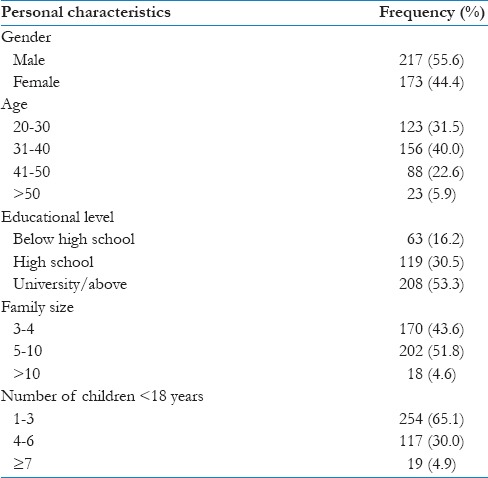
Parents’ awareness regarding first aid
As shown in Table 2, majority of the parents (97.2%) were aware of first aid. The commonest reported source of information about the first aid was mass media (59%), followed by school books (14.9%). Only 13% of them reported that the source of their information was doctors or nurses.
Table 2.
Parents’ awareness of first aid and their sources of information (n=390)
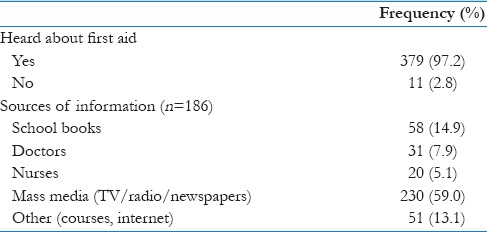
Parents’ training in first aid
Majority of the parents (93.3%) believe that there must be training in first aid and only 34.6% of them claimed that they attended training course in first aid. Most of those attended first-aid training course (74.8%) reported that these courses included practical training and majority of them (82.2%) claimed that they were beneficial. Only 24.1% of parents felt confident in managing incidents needing first aid among their children while 54.5% of them felt somewhat confidence in managing incidents needing first aid among their children. Majority of the parents (90.3%) answered that if they were invited to attend first aid training course at primary healthcare center, they will attend [Table 3].
Table 3.
Parents’ history of training in first aid (n=390)
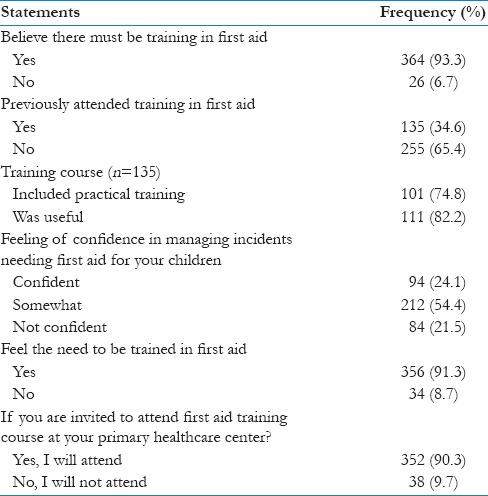
Parents’ experience and practice of first among their children
As obvious from Figure 1, more than half of the parents (58.7%) had experience with incidents among their children. Wounds, burning, and seizures were the most common reported incidents (21%, 14.4%, and 8.3%, respectively). Two types or more were reported by 42.8% of parents [Figure 2]. Most of the parents, who had experience with incidents among their children, provided first aid to incident cases (72.5%) as shown in Figure 3.
Figure 1.
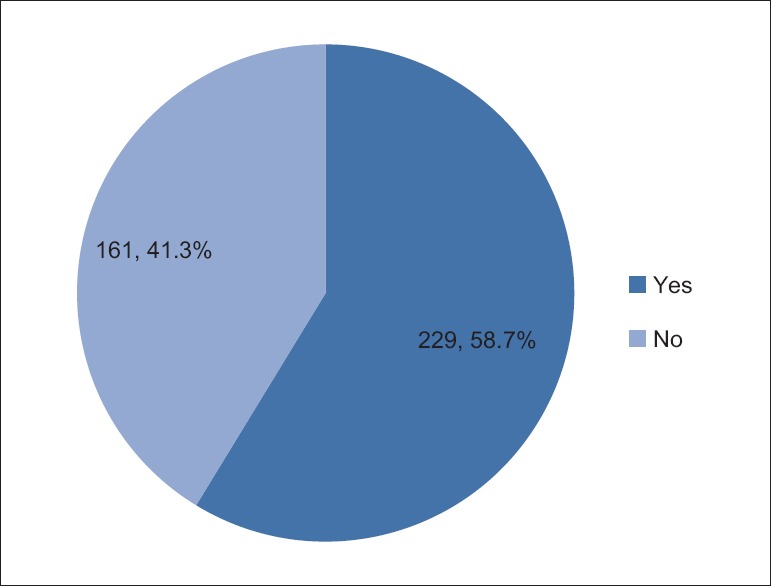
Parents’ history of having experience with incident among their children (n = 390)
Figure 2.

Incident types among children experienced by parents (n = 229)
Figure 3.
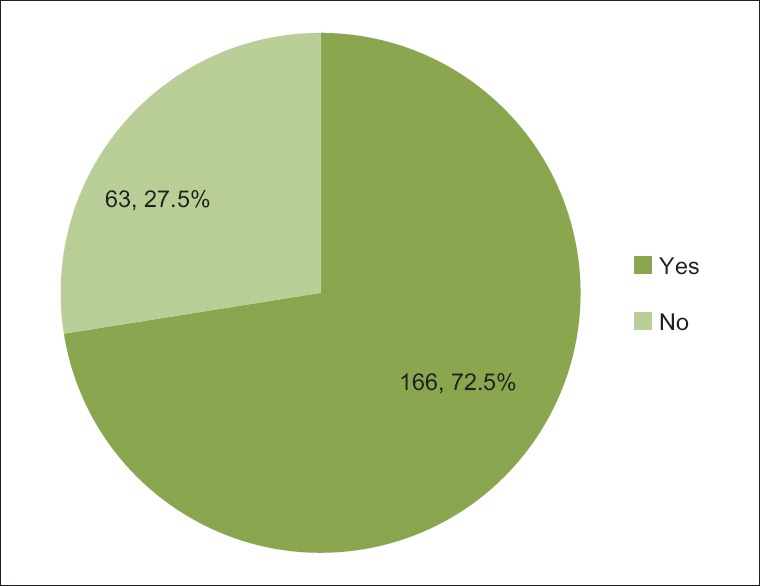
History of providing first aid to incident cases by parents (n = 229)
Parents’ knowledge about first aid for various incidents
As shown in Table 4, most of the parents (73.1%) knew that person with burned clothes should be covered with a blanket and almost two-thirds of them recognized correctly that in case of chalking, a head tilt maneuver with chest up and rubbing the back gently should be applied (69.7) and that for a person who loss conscious, it is possible to regain play only after medical examination (66.4%). On the other hand, only 12.8% of parents knew the proper way of dealing with a foreign body in the ear, 9.5% knew how to deal with a case of insect sting without seeing the insect spike on examination, and just 9.2% could recognize correctly the way of dealing with swallowing of poisonous chemical material.
Table 4.
Parents’ knowledge about first aid for various incidents

Parents’ knowledge about first aid for injuries/fractures
From Table 5, it is seen that most of the parents (76.7%) knew correctly that for small cut wound while playing, the proper first aid measure is to clean the wound and compress at injury site whenever needed. Slightly more than half of them (51.8%) knew that in case of query hand fracture, a hand slap should be placed and then the patient should be transferred to the hospital. Only 12.3% of them knew that other than prescribed by physicians, ice should be used in sports injury within the first 48 h.
Table 5.
Parents’ knowledge about first aid for injuries/fractures

Parents’ knowledge about first aid for epilepsy
Most of the parents (72.8%) could recognize that epileptic patient has learning difficulty, if not properly managed and almost two-thirds of them (66.4%) knew that during the epileptic fit, it is not important to give the patient water and sugar to stop the attack. More than half of them (55.4%) knew that usually epileptic seizures begin and end spontaneously without need for special precautions. Only 19.5% of them knew that it is not important for the child to open his/her mouth during an epileptic fit to avoid tongue biting [Table 6].
Table 6.
Parents’ knowledge about first aid for epilepsy

Parents’ knowledge about first aid for diabetes mellitus
Majority of the parents (91.8%) knew that it is essential for diabetic patient to have balanced diet and snacks (81.5%). Almost two-thirds of parents (66.9%) knew that if a diabetic patient is complaining of thirst, vomiting, and gastric pain, mostly blood glucose is high and slightly more than half of them (52.3%) knew that it is not possible treat this case at home. On the other hand, 57.7% of them knew that if the diabetic patient is complaining of drowsiness, sweating, disturbed mood, mostly blood glucose is low and 62.3% of the parents could recognize that it is possible to treat this case at home [Table 7].
Table 7.
Parents’ knowledge about first aid for diabetes mellitus

From Figure 4, it is obvious that the highest average knowledge percentage was observed regarding first aid of diabetes mellitus (68.8%), followed by epilepsy (49.7%), incidents (37.5%), and finally injuries/fractures (36.7%).
Figure 4.

Overall knowledge percent of different items of first aid
The total score of first-aid knowledge among the participants ranged between 4 and 23 out of 29 maximum score with a mean of 13.4 ± 3.04. The distribution was abnormal according to Shapiro–Wilk test, P = 0.002.
As shown in Figure 5, 45.1% of the participants reported having first-aid bag at home. Slightly less than half of them (48.5%) knew the ambulance number [Figure 6].
Figure 5.
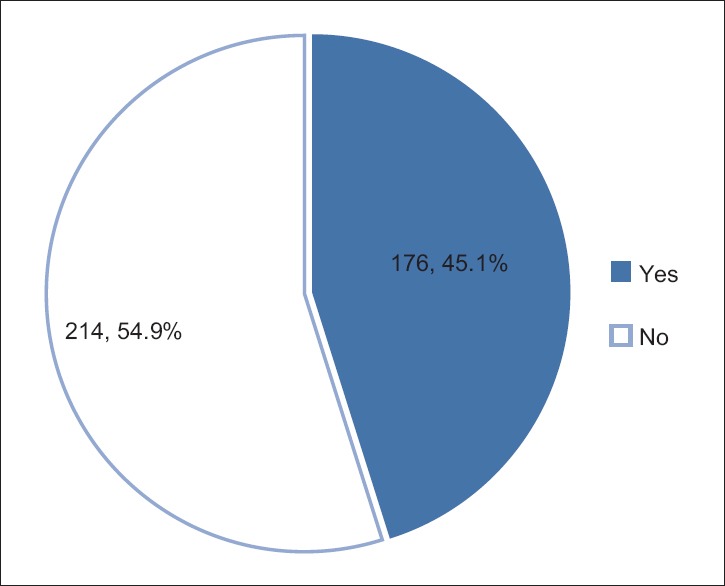
History of having first-aid bag at home of the participants
Figure 6.

Knowledge of the ambulance number among the participants
Factors associated with first-aid knowledge among parents
Sociodemographic characteristics
From Table 8, it is seen that higher educated parents (university/above) were more likely to have better first-aid knowledge compared to lower educated (below high school and high school educated), the mean ranks were 221.2 versus 164 and 167, respectively. This difference was statistically significant, P < 0.001. Regarding the number of children below 18 years, the highest level of first-aid knowledge was reported among parents with 4–6 children (mean rank = 213.7) whereas the lowest level of first aid knowledge was observed among parents with more than 6 children (mean rank = 143), P = 0.022. Gender of the parent, age, and family size were not significantly associated with first-aid knowledge.
Table 8.
Association between parents’ sociodemographic characteristics and first-aid knowledge
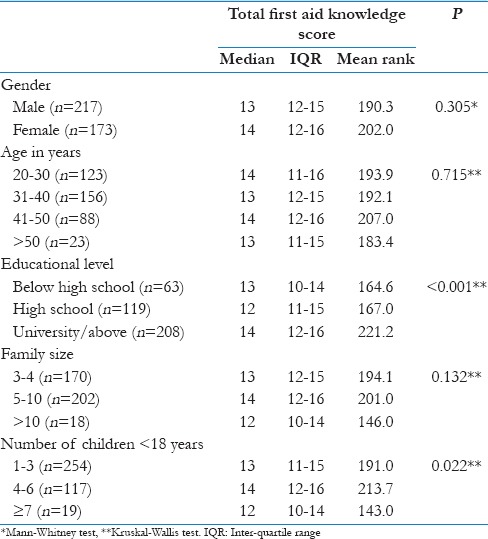
Parents’ awareness and source of first-aid information
From Table 9, it is shown that parents’ awareness of first aid was not significantly associated with their knowledge level regarding it. However, those reported nurses as the main source of information were more knowledgeable than those reported school books (mean ranks were 234.4 and 197.4, respectively). The difference was borderline insignificant, P = 0.051.
Table 9.
Association between parents’ awareness and source of information and first-aid knowledge
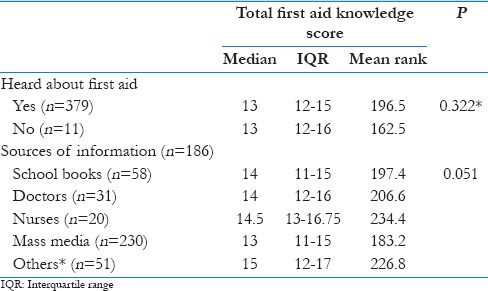
Parents’ training and experience
Parents who reported previous attending training in first aid expressed higher significantly first aid knowledge compared to those who did not attend such courses (mean ranks were 230.7 vs. 176.9), P < 0.001. Parents who had experience with incidents among their children were more knowledgeable regarding first aid than those who had no such experience (mean ranks were 207.1 and 179, respectively), P = 0.015. Parents who knew the ambulance number were more knowledgeable regarding first aid than those who did not know (mean ranks were 220.9 and 171.7, respectively), P < 0.001. History of providing first aid to incident cases by parents and having first aid bag at home of the participants were not significantly associated with parental first-aid knowledge; however, P value with near to significant level (0.056) [Table 10].
Table 10.
Association between parents’ training and experience and first aid knowledge
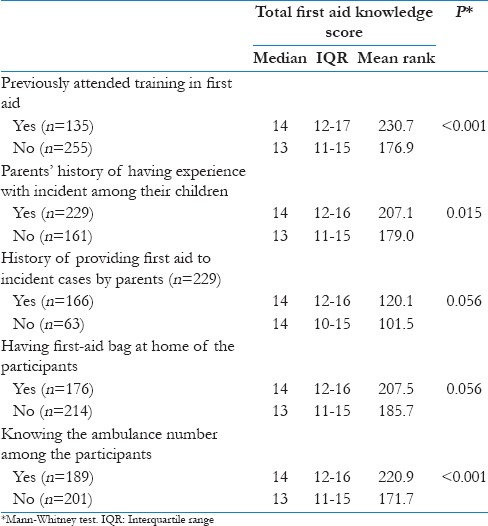
Discussion
Most of the accidents happened to children at home can be avoided or minimized if parents, particularly mothers knew what to do as soon as they happen.[5] Recent literature reported that the home accidents, incidents, and injuries can be successfully prevented or at least became less serious.[5,6,7]
As there is no clear view regarding the level of awareness and knowledge about first aid measures among parents in Al-Madinah city, this study was carried out to assess the knowledge and practice of first aid among parents attending PHCs in Al-Madinah city, 2017.
Fortunately, in the present study, majority of the parents (97.2%) have heard of first aid. This figure is higher than those reported from other studies. In a study carried out among rural mothers in Egypt, 26.6% had not heard about the term.[8] In India, almost two-thirds of the studied women had not heard about first aid (65.7%).[9] This difference between studies could be attributed to the difference in demographic characteristics of the populations.
In the present study, the most commonly reported source of information was mass media (TV/radio and newspapers) (59%). Similarly, in Egypt, 56.1% of rural mothers reported that TV and radio were the sources of their knowledge.[8] In India, mass media (TV/radio) presented 45.8% of the sources of knowledge.[9] Even in a previous study carried out in Riyadh, Saudi Arabia, the main source of information regarding first aid among parents was mass media.[10] These results enforced the role of mass media in transferring information about first aid to general population. Therefore, care must be paid to the quality of information in mass media.
In the present study and agreement with those carried out in Riyadh,[10] Egypt[8] and India,[9] majority of the mothers (93.3%) agreed that they should know about first aid and they were all willing to undergo training on first aid. This is a good finding which should encourage authorities to organize and implement effective programs in the first aid for parents in Al-Madinah city.
In the present study, almost one-third of the parents reported attending training courses in first aid and they included practical sessions in most cases. In Riyadh,[10] only 22% of mothers had previous formal training in pediatric first aid.
The total score of first aid knowledge among the participants in the present study ranged between 4 and 23 out of 29 maximum score with a mean of 13.4 ± 3.04. In a similar study carried out in Egypt,[8] the mean knowledge score of mothers was 11.0 ± 5.3 out of 29. This indicates that the knowledge of parents regarding first aid is below average.
In the present study, only 21% of parents knew that the first step in caring for a bleeding wound is compression at the bleeding site. In a similar Indian study,[11] the most common practice applied for first aid of a cut with bleeding was the application of turmeric powder. Also in an old study conducted among high school children in India,[11] majority of the children (84.6%) reported application of turmeric powder as a first aid on a wound with bleeding.[11]
Regarding dealing with burns, 45.9% of parents in the present study claimed that in case of burn, they will keep the burned site under cold water whereas most of them 73.1% knew that person with burned clothes should be covered with a blanket. In Riyadh,[10] only 27.9% of parents had the knowledge regarding the use of ice on the burns. Other studies have documented the application of different substances such as coconut oil, tooth paste, butter on burn wounds as a first-aid measure,[9,12] which could lead to wound infection. In addition, in another study carried out in Riyadh, 32% of parents treated burns with nonscientific remedies alone or in combination, including honey, egg white, toothpaste, white flour, tomato paste, yogurt, tea, sliced potato, or butter and almost two-thirds (65%) of caregivers covered a pot of oil on fire with a wet cloth, whereas only 24% reported smothering burning clothes.[13]
Regarding nasal foreign body, only 36.9% of parents could recognize the proper action which is trying to make the child sneeze by any mean. However, the person has to inhale deep in before sneezing.[14]
Epistaxis is an alarming condition that might occur frequently among children either spontaneously or secondary to trauma. However, most parents may not have satisfactory knowledge about the first-aid management of cases of epistaxis. In the present research, only 27.9% of parents answered correctly how to manage a case of epistaxis. Singer et al. in the USA revealed that most mothers had proper knowledge about the first-aid actions to be taken when faced with epistaxis.[15] In Riyadh,[10] only 16.4% of parents were aware of keeping the child in a sitting position with the head tilted slightly backward for nose-bleeds.
In the present survey, only 12.8% of mothers know how to deal properly with a case of choking, although more than one-third of them reported attending first-aid courses which indicates unsatisfactory effectiveness of trainings. In a study carried out in Poland,[16] 42% of mothers would not be able to help choking children whereas 52% were not sure about their skills. In Riyadh, only 22.2% of parents were aware of the importance of removing the foreign body in case of choking.[10] In Al-Khobar city, 80.8% of the females and 86.5% of males were totally unaware of cardiopulmonary resuscitation (CPR), which is very essential in case of chocking.[17] In Taiwan, the lowest scores for self-efficacy among parents were with regard to choking and CPR.[18]
In the present study, 55.4% of parents knew that usually epileptic seizures begin and end spontaneously without need for special precautions. In India, only 6.4% of rural mothers could identify the appropriate first aid for a person having a seizure attack.[9] In another Saudi study, mothers of children with epilepsy were not well informed on what to do during acute seizures. They had negative behavior and poor management practices. Although many of them (41%) have experienced at least one prolonged (>10 min) seizure, their level of knowledge was not strong, and 26% felt not knowledgeable at all.[19]
Fortunately, the present study revealed that the mothers’ knowledge regarding dealing with emergency cases of diabetes is satisfactory and represent the highest level of knowledge regarding first aid. Almost two-thirds of them and more than half could recognize the symptoms of hyperglycemia and hypoglycemia, respectively. Quite similar results have been documented in a study carried out by Joseph et al. in the UK.[20]
Possible factors associated with knowledge of first aid were investigated in the current study and revealed that higher educated parents were more likely to have better first aid knowledge compared to lower educated. In addition, parents with moderate number of children (4–6) were more knowledgeable than those with higher number of children (>6). Parents reported nurses as the main source of information were more knowledgeable than those reported school books. This finding highlights the importance of healthcare staff, particularly nurses in delivering first-aid knowledge. Parents who reported previous attending training in first aid expressed higher significantly first-aid knowledge compared to those who did not attend such courses. Parents who had experience with incidents among their children were more knowledgeable regarding first aid than those who had no such experience. Therefore, attending training courses in first aid is very essential in having better knowledge and consequently practice regarding first aid. Parents who knew the ambulance number were more knowledgeable regarding first aid than those who did not know. However, because of cross-sectional design of the study, possibly better knowledge lead to knowing of the ambulance number and not vice versa. In a similar study carried out in Egypt,[8] mothers of younger age, university and postgraduate educated, in health-related occupations, of higher socioeconomic status and those who had attended training course(s) on first aid had the highest knowledge score. In Singapore, it has been reported that the higher the education of the mother, the more likely she had higher knowledge and practice score regarding first aid of childhood injuries.[21] In Turkey, Tomruk et al. observed that mothers who were healthcare personnel, had graduated from a university, had taken a first aid course, or had a first-aid certificate expressed better first-aid knowledge.[22]
Among study strengths is the inclusion of relatively large number of parents and using of a concise questionnaire with its all questions were closed ended. However, the study has an important limitation as a result of its cross-sectional design which investigates only the association and not the temporal causality between variables.
Conclusions
First aid of various illnesses among parents in Al-Madinah city is not satisfactory, particularly regarding incidents, injuries, and fractures. Knowledge about first aid of diabetic crises is acceptable. Higher educated parents, those with previous experience of incidents among their children and those attending training courses in first aid were more knowledgeable about first aid. Mass media (TV/radio/newspapers) was the main source of information regarding first aid. Majority of the parents were willing to attend first-aid training course at primary healthcare centers.
Recommendations
First-aid training programs should be conducted at primary healthcare centers in Al-Madinah city for parents of children to decrease the early mortality and morbidity of emergencies
Encouraging doctor and nurse to educate people attending primary healthcare centers regarding first-aid measures
Training should be repetitive and involve actual practice to gain the required skills
Incorporation of first-aid issues in the school curriculum
Further study on larger scale should be conducted to generalize the findings over the whole population and not only those attending primary healthcare centers. This study can be done in rural and urban areas.
Financial support and sponsorship
Nil.
Conflicts of interest
There are no conflicts of interest.
Acknowledgment
Special thanks go to the directors and physicians of the involved primary healthcare centers, for their continuous support during the fields work of the present research.
We are grateful to all parents participated in this study for their cooperation.
References
- 1.Peden M, Oyegbite K. World Report on Child Injury Prevention. World Health Organization; 2008. [Last cited on 2018 Jan 11]. Available from: http://www.who.int/violence_injury_prevention/child/injury/world_report/en/ [PubMed] [Google Scholar]
- 2.Singletary EM, Charlton NP, Epstein JL, Ferguson JD, Jensen JL, MacPherson AI, et al. Part 15:First aid: 2015 American Heart Association and american red cross guidelines update for first aid. Circulation. 2015;132:S574–89. doi: 10.1161/CIR.0000000000000269. [DOI] [PubMed] [Google Scholar]
- 3.General Authority for Statistics (GASTAT) [Homepage on the Internet]. Saudi Arabia. Statistical year book of 2016. [Last cited on 2018 Feb 01]. Available from: https://www.stats.gov.sa/ar/169 .
- 4.Al-Samghan AS, Al-Shahrani FM, Al-Shahrani FH. Primary school teachers knowledge about first-aid. Medical Journal of Cairo University. 2015;83:541–7. [Google Scholar]
- 5.Hema VH, Dilli Babu M. A descriptive study to assess the level of knowledge regarding first aid management of domestic accidents among mothers of under five children and safety practices at home in rural village, Chennai. Int J Nurs Patient Saf Care. 2016;1:31–8. [Google Scholar]
- 6.Kamel EG, Emam SA, Mohammed ES. Knowledge, attitude and practice among rural mothers about home-related injuries in a rural area in El-Minia. Science Journal of Public Health. 2014;2:653–9. [Google Scholar]
- 7.Bánfai B, Deutsch K, Pék E, Radnai B, Betlehem J. Accident prevention and first aid knowledge among preschool children's parents. Journal of Nursing and Social Sciences related to Health and Illness. 2015;1:49–54. [Google Scholar]
- 8.Eldosoky RS. Home-related injuries among children: Knowledge, attitudes and practice about first aid among rural mothers. East Mediterr Health J. 2012;18:1021–7. doi: 10.26719/2012.18.10.1021. [DOI] [PubMed] [Google Scholar]
- 9.Sonavane R, Kasturi A, Kiran D, Kumari R. Knowledge and assessed practice regarding first aid among mothers of under 15 years children – A community based study in a rural area of South India. Al Ameen J Med Sci. 2014;7:284–90. [Google Scholar]
- 10.Almass A, Alshahrani B, Almweisheer A, Alshlewi A. Awareness and practice of pediatric first aid among parents in Saudi Arabia: Cross-sectional study. J Health Spec. 2015;3:84–5. [Google Scholar]
- 11.Singh AJ, Kaur A. Knowledge Attitude practices of urban and rural high school children regarding minor injuries. Indian J Public Health. 1995;34:23–5. [PubMed] [Google Scholar]
- 12.Rawlins JM, Khan AA, Shenton AF, Sharpe DT. Burn patterns of Asian ethnic minorities living in West Yorkshire, UK. Burns. 2006;32:97–103. doi: 10.1016/j.burns.2005.08.013. [DOI] [PubMed] [Google Scholar]
- 13.Alomar M, AL F, Eldali A. Science direct knowledge, attitude, and belief regarding burn first aid among caregivers attending pediatric emergency medicine departments. Burns. 2016;42:938–43. doi: 10.1016/j.burns.2016.03.019. [DOI] [PubMed] [Google Scholar]
- 14.Hall S, Colman BH. Diseases of Nasal Cavity. 10th ed. England: Livingstone Ltd; 1973. p. 59. [Google Scholar]
- 15.Singer AJ, Gulla J, Thode HC, Jr, Cronin KA. Pediatric first aid knowledge among parents. Pediatr Emerg Care. 2004;20:808–11. doi: 10.1097/01.pec.0000148028.53598.5c. [DOI] [PubMed] [Google Scholar]
- 16.Karyś J, Jędrasik M, Karyś T, Rębak D. Mothers’ knowledge of administration of first aid to preschoolers in choking incidents. Arch Physiother Glob Res. 2016;20:23–9. [Google Scholar]
- 17.Al-Turkistani HK. Awareness and knowledge of pediatric cardio- pulmonary resuscitation in the community of Al-Khobar city. J Family Community Med. 2014;21:125–9. doi: 10.4103/2230-8229.134772. [DOI] [PMC free article] [PubMed] [Google Scholar]
- 18.Wei YL, Chen LL, Li TC, Ma WF, Peng NH, Huang LC, et al. Self-efficacy of first aid for home accidents among parents with 0- to 4-year-old children at a metropolitan community health center in Taiwan. Accid Anal Prev. 2013;52:182–7. doi: 10.1016/j.aap.2012.12.002. [DOI] [PubMed] [Google Scholar]
- 19.Hall-Parkinson D, Tapper J, Melbourne-Chambers R. Parent and caregiver knowledge, beliefs, and responses to convulsive seizures in children in Kingston, Jamaica – A hospital-based survey. Epilepsy Behav. 2015;51:306–11. doi: 10.1016/j.yebeh.2015.08.001. [DOI] [PubMed] [Google Scholar]
- 20.Joseph L, Bentley A, Mathew V. Parental diabetes knowledge and glycaemic control of their children: A questionnaire study. Endocrine. 2008;17:45. [Google Scholar]
- 21.Thein MM, Lee BW, Bun PY. Knowledge, attitude and practices of childhood injuries and their prevention by primary caregivers in Singapore. Singapore Med J. 2005;46:122–6. [PubMed] [Google Scholar]
- 22.Tomruk O, Soysal S, Gunay T, Cimrin AH. First aid: Level of knowledge of relatives and bystanders in emergency situations. Adv Ther. 2007;24:691–9. doi: 10.1007/BF02849962. [DOI] [PubMed] [Google Scholar]


